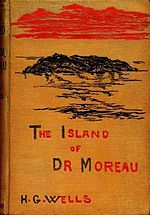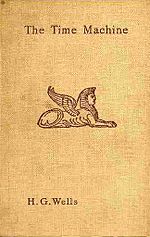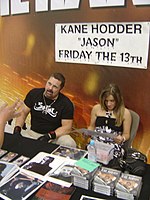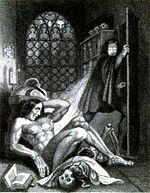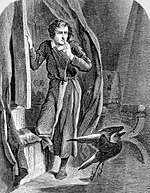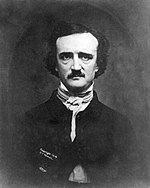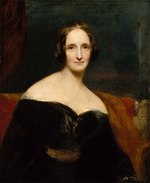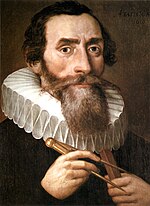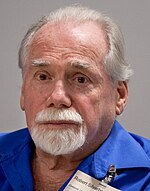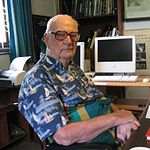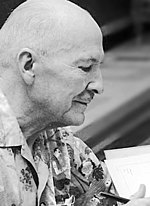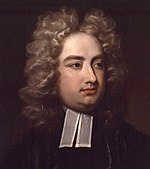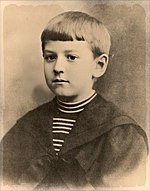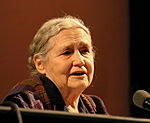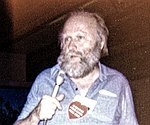Portal:Speculative fiction/Selected works/Main
Selected works
Usage
The layout design for these subpages is at Portal:Speculative fiction/Selected works/Layout.
- Add a new Selected work to the next available subpage.
- Update "max=" to new total for its {{Random portal component}} on the main page. (Edit main page)
Selected works lists
Science fiction
Portal:Speculative fiction/Selected science fiction work/1
Set in 2004, the film follows a group of
The film was released on August 13, 2004, in North America and received mostly negative reviews from film critics. Some praised the special effects and set designs, while others dismissed the film for its "wooden dialogue" and "cardboard characters". Nevertheless, Alien vs. Predator was a commercial success, grossing over $172 million against its $60 million production budget. The film's success led to a sequel in 2007 titled Aliens vs. Predator: Requiem.
Portal:Speculative fiction/Selected science fiction work/2 Blade Runner is a 1982 American science fiction film directed by Ridley Scott and starring Harrison Ford, Rutger Hauer, and Sean Young. The screenplay, written by Hampton Fancher and David Peoples, is based loosely on the novel Do Androids Dream of Electric Sheep? by Philip K. Dick.
The film depicts a
Blade Runner initially polarized
Seven versions of the film have been shown for various markets as a result of controversial changes made by film executives. A rushed director's cut was released in 1992 after a strong response to workprint screenings. This, in conjunction with its popularity as a video rental, made it one of the first films released on DVD, resulting in a basic disc with mediocre video and audio quality. In 2007, Warner Bros. released in select theaters, and on DVD/HD DVD/Blu-ray, the 25th anniversary digitally remastered definitive Final Cut by Scott.
Portal:Speculative fiction/Selected science fiction work/3
Grant avoided using the character often, but addressed multiple issues whenever the character appeared, including environmentalism,
Originally intended to only be used in the debut story in which he appeared, Anarky was created to be a violent but highly intelligent youth who rationalized murder in the name of a higher cause. At the request of Dennis O'Neil, this early interpretation was altered before publication, and Anarky was instead portrayed as violent but non-lethal. Following positive reception by readers and Dennis O'Neil, Grant decided to continue using Anarky as a recurring character throughout the early 90s.
Portal:Speculative fiction/Selected science fiction work/4 page, though fiction content was still restricted to a single novel. In 1952 short fiction began to appear alongside the novels, and within two more years it had completed the transformation into a science fiction magazine.
Authentic published little in the way of important or ground-breaking fiction, though it did print Charles L. Harness's "The Rose," which later became well-regarded. The poor rates of pay—£1 per 1,000 words—prevented the magazine from attracting the best writers. During much of its life it competed against three other moderately successful British science fiction magazines, as well as the American science fiction magazine market. Hamilton folded the magazine in October 1957, because they needed cash to finance an investment in the UK rights to an American best-selling novel.
Portal:Speculative fiction/Selected science fiction work/5 Battlefield Earth: A Saga of the Year 3000 is a 2000 American film adaptation of the novel Battlefield Earth by L. Ron Hubbard. Directed by Roger Christian, the film stars John Travolta, Forest Whitaker, and Barry Pepper. The film depicts an Earth that has been under the rule of the alien Psychlos for 1,000 years and tells the story of the rebellion that develops when the Psychlos attempt to use the surviving humans as gold miners.
Travolta, a long-time Scientologist, had sought for many years to make a film of the novel by Hubbard, the founder of Scientology. He was unable to obtain funding from any major studio due to concerns about the film's script, prospects, and connections with Scientology. The project was eventually taken on by an independent production company, Franchise Pictures, which specialized in rescuing stars' stalled pet projects. Travolta signed on as a co-producer and contributed millions of dollars of his own money to the production, which was largely funded by a German film distribution company. Franchise Pictures was later sued by its investors and was bankrupted after it emerged that it had fraudulently overstated the film's budget by $31 million.
Battlefield Earth was released on May 12, 2000. The film was a major
Portal:Speculative fiction/Selected science fiction work/6 Professor Bernard Quatermass is a fictional character, originally created by the writer Nigel Kneale for BBC Television. Quatermass appeared in three influential BBC science fiction serials of the 1950s (The Quatermass Experiment, Quatermass II, and Quatermass and the Pit), and returned in a final serial for Thames Television in 1979 (Quatermass). A remake of the first serial appeared on BBC Four in 2005.
The character also appeared in films, on the radio and in print over a fifty-year period. Kneale picked the character's unusual surname from a London telephone directory, while the first name was in honour of the astronomer Bernard Lovell. Quatermass is an intelligent and highly moral British scientist, who continually finds himself confronting sinister alien forces that threaten to destroy humanity. In the initial three serials he is a pioneer of the British space programme, heading up the British Experimental Rocket Group.
The character of Quatermass has been described by BBC News Online as Britain's first television hero, and by The Independent newspaper as "A brilliantly conceived and finely crafted creation... [He] remained a modern 'Mr Standfast', the one fixed point in an increasingly dreadful and ever-shifting universe." In 2005, an article in The Daily Telegraph suggested that "You can see a line running through him and many other British heroes. He shares elements with both Sherlock Holmes and Ellen MacArthur."
Portal:Speculative fiction/Selected science fiction work/7
Due to its large
Portal:Speculative fiction/Selected science fiction work/8 Pattern Recognition is a novel by science fiction writer William Gibson published in 2003. Set in August and September 2002, the story follows Cayce Pollard, a 32-year-old marketing consultant who has a psychological sensitivity to corporate symbols. The action takes place in London, Tokyo, and Moscow as Cayce judges the effectiveness of a proposed corporate symbol and is hired to seek the creators of film clips anonymously posted to the internet.
The novel's central theme involves the examination of the human desire to detect patterns or meaning and the risks of finding patterns in meaningless data. Other themes include methods of interpretation of history, cultural familiarity with brand names, and tensions between art and commercialization. The
The novel is Gibson's eighth and the first to be set in the contemporary world. Like his previous work, it has been classified as a science fiction and
Portal:Speculative fiction/Selected science fiction work/9
The book follows a year in Raptor Red's life as she loses her mate, finds her family, and struggles to survive in a hostile environment. Bakker drew inspiration from
When released, Raptor Red was generally praised: Bakker's anthropomorphism was seen as a unique and positive aspect of the book, and his writing was described as folksy and heartfelt. Criticisms of the novel included a perceived lack of characterization and average writing. Some scientists, such as paleontologist David B. Norman, took issue with the scientific theories portrayed in the novel, fearing that the public would accept them as fact, while Discovery Channel host Jay Ingram defended Bakker's creative decisions in an editorial.
Portal:Speculative fiction/Selected science fiction work/10 Starship Troopers is a military science fiction novel by Robert A. Heinlein, first published (in abridged form) as a serial in The Magazine of Fantasy & Science Fiction (October, November 1959, as "Starship Soldier") and published hardcover in December, 1959.
The
Starship Troopers won the Hugo Award for Best Novel in 1960. The novel has attracted controversy and criticism for its social and political themes, which some critics claim promote militarism. Starship Troopers has been adapted into several films and games, with the most widely known being the 1997 film by Paul Verhoeven.
Portal:Speculative fiction/Selected science fiction work/11
There were also two series of towels, produced by Beer-Davies, that are considered by some fans to be an "official version" of The Hitchhiker's Guide to the Galaxy, as they include text from the first novel. A
The title is the name of a fictional, eccentric, electronic
Portal:Speculative fiction/Selected science fiction work/12
The trilogy comprises The Eye in the Pyramid, The Golden Apple and Leviathan. They were first published as three separate volumes starting in September 1975. In 1984 they were published as an omnibus edition, and are now more commonly reprinted in the latter form. In 1986 the trilogy won the Prometheus Hall of Fame Award, designed to honor classic libertarian fiction. The authors went on to write several works, both fiction and nonfiction, that dealt further with the themes of the trilogy, but they did not write any direct sequels.
Portal:Speculative fiction/Selected science fiction work/13 The Time Traveler's Wife, published in 2003, is the debut novel of American author Audrey Niffenegger. It is a love story about a man with a genetic disorder that causes him to time travel unpredictably, and about his wife, an artist, who has to cope with his frequent absences and dangerous experiences. Niffenegger, frustrated in love when she began the work, wrote the story as a metaphor for her failed relationships. The tale's central relationship came to her suddenly and subsequently supplied the novel's title. The novel, which has been classified as both science fiction and romance, examines issues of love, loss, and free will. In particular, it uses time travel to explore miscommunication and distance in relationships, while also investigating deeper existential questions.
As a first-time novelist, Niffenegger had trouble finding a
Portal:Speculative fiction/Selected science fiction work/14
The character first appeared in 1910. New titles have been published as recently as 2007. Most of the various series focus on Tom’s inventions, a number of which have anticipated actual inventions. The character has been presented in different ways over the years. In general, the books portray science and technology as wholly beneficial in their effects, and the role of the inventor in society has been treated as admirable and heroic.
Translated into a number of languages, the books have sold over 20 million copies worldwide. Tom Swift has also been the subject of a board game and a television show. Development of a feature film based on the series was announced in 2008. A number of prominent figures, including Steve Wozniak and Isaac Asimov, have cited "Tom Swift" as an inspiration. Several inventions, including the taser, have been directly inspired by the fictional inventions.
Portal:Speculative fiction/Selected science fiction work/15
It begins with the protagonist, an upper class gentleman who was named Edward Prendick, finding himself shipwrecked in the ocean. A passing ship takes him aboard, and a doctor named Montgomery revives him. He explains to Prendick that they are bound for an unnamed island where he works, and that the animals aboard the ship are traveling with him. Prendick also meets a grotesque, bestial native named M'ling, who appears to be Montgomery's manservant.
When they arrive on the island, however, both the captain of the ship and Doctor Montgomery refuse to take Prendick with either of them, stranding him between the ship and the island. The crew pushes him back into the lifeboat from which they rescued him. When they see that the ship truly intends to abandon him, the islanders take pity and end up coming back for him. Montgomery introduces him to Doctor Moreau, a cold and precise man who conducts research on the island. After unloading the animals from the boat, they decide to house Prendick in an outer room of the enclosure in which they live. Prendick is exceedingly curious about what exactly Moreau researches on the island, especially after he locks the inner part of the enclosure without explaining why. Prendick suddenly remembers that he has heard of Moreau, and that he had been an eminent physiologist in London before a journalist exposed his gruesome experiments in vivisection.
Portal:Speculative fiction/Selected science fiction work/16
Russian writer
Portal:Speculative fiction/Selected science fiction work/17
The War of the Worlds is split into two parts : Book one: The Coming of the Martians and Book two: The Earth under the Martians. The novel is narrated by an unnamed writer of philosophical articles. Throughout the narrative he struggles to reunite with his wife, while witnessing the Martians rampaging through the southern English counties. Part one also features the tale of his brother, who accompanies two women to the coast in the hope of escaping England as it is invaded.
The plot has been related to
Portal:Speculative fiction/Selected science fiction work/18
Wells had considered the notion of
The story reflects Wells's own
Portal:Speculative fiction/Selected science fiction work/19 Odd John: A Story Between Jest and Earnest is a 1935 science fiction novel by the British author Olaf Stapledon. The novel explores the theme of the Übermensch (superman) in the character of John Wainwright, whose supernormal human mentality inevitably leads to conflict with normal human society and to the destruction of the utopian colony founded by John and other superhumans.
The novel resonates with the ideas of
Portal:Speculative fiction/Selected science fiction work/20
A controversial part of the book depicts humans, in the far-off future, escaping the dying Earth and settling on Venus — in the process totally exterminating its native inhabitants, an intelligent marine species. Stapledon's book has been interpreted by some as condoning such interplanetary genocide as a justified act if necessary for racial survival, though a number of Stapledon's partisans denied that such was his intention, arguing instead that Stapledon was merely showing that although mankind had advanced in a number of ways in the future, at bottom it still possessed the same capacity for savagery as it has always had.
Portal:Speculative fiction/Selected science fiction work/21 Star Maker is an influential science fiction novel by Olaf Stapledon, written in 1937. Stapledon undertakes the immense task of describing the entire history of life in the universe. It dwarfs in scale even his 1930 book Last and First Men, which is a history of the human species over two billion years. It tackles philosophical themes such as the essence of life, of birth, decay and death, and the relationship between creation and creator. The narrator starts with a concern at the clash of ideas on Earth and finds analogies to both communism and fascism among the aliens he visits.
A pervading theme is that of progressive unity within and between different civilizations. Some of the elements and themes briefly discussed prefigure later fiction concerning genetic engineering and alien life forms. Arthur C. Clarke considered Star Maker to be one of the finest works of science fiction ever written.
Portal:Speculative fiction/Selected science fiction work/22 Dune is a science fiction novel written by Frank Herbert, published in 1965. It won the Hugo Award in 1966, and also the inaugural Nebula Award for Best Novel. Dune is frequently cited as the world's best-selling science fiction novel.
Set in the far future amidst a sprawling
Herbert wrote five
Portal:Speculative fiction/Selected science fiction work/23
The original title was Animal Farm: A Fairy Story, but A Fairy Story was dropped by the US publishers for its 1946 publication. Of all the translations during Orwell's lifetime, only Telugu kept the original title. Other variations in the title include: A Satire and A Contemporary Satire. Orwell suggested for the French translation the title Union des républiques socialistes animales, recalling the French name of the Soviet Union, Union des républiques socialistes soviétiques, and which abbreviates URSA, which means "bear", a symbol of Russia, in Latin.
Portal:Speculative fiction/Selected science fiction work/24
Set in 2525, twenty-seven years before the events of
Portal:Speculative fiction/Selected science fiction work/25
The series is set in the year 2517, after the arrival of humans in a new star system, and follows the adventures of the renegade crew of Serenity, a "Firefly-class" spaceship. The ensemble cast portrays the nine characters who live on Serenity. Whedon pitched the show as "nine people looking into the blackness of space and seeing nine different things". The show explores the lives of people who fought on the losing side of a civil war who now make a living on the outskirts of the society, as part of the pioneer culture that exists on the fringes of their star system. In addition, it is a future where the only two surviving superpowers, the United States and China, fused to form the central federal government, called the Alliance, resulting in the fusion of the two cultures as well. According to Whedon's vision, "nothing will change in the future: technology will advance, but we will still have the same political, moral, and ethical problems as today."
Portal:Speculative fiction/Selected science fiction work/26
The Three Laws of Robotics are a set of three science fiction laws written by Isaac Asimov, which most robots appearing in his fiction have to obey. First introduced in his short story "Runaround" (1942), they state the following:1. A robot may not harm a human being, or, through inaction, allow a human being to come to harm.
2. A robot must obey the orders given to it by human beings except where such orders would conflict with the First Law.
3. A robot must protect its own existence, as long as such protection does not conflict with the First or Second Law.
The Three Laws are an organizing principle and unifying theme for Asimov's fiction, appearing in the Foundation series and the other stories linked to it, as well as Lucky Starr and the Moons of Jupiter. Other authors working in Asimov's fictional universe have adopted them, and references (often parodic) appear throughout science fiction and in other genres. Technologists in the field of artificial intelligence, working to create real machines with some of the properties of Asimov's robots, have speculated upon the role the Three Laws play in such research.
Portal:Speculative fiction/Selected science fiction work/27
The Prisoner is a 1967 British science fiction-allegorical television series about an unidentified British intelligence agent who is abducted and imprisoned in a mysterious coastal village, where his captors try to find out why he abruptly resigned from his job. It was created by Patrick McGoohan and George Markstein with McGoohan playing the main role of Number Six. Episodes covered various plots from spy fiction with elements of science fiction, allegory and psychological drama. It was produced by Everyman Films for distribution by Lew Grade's ITC Entertainment company.A single season of 17 episodes was filmed between September 1966 and January 1968 with
Portal:Speculative fiction/Selected science fiction work/28
The Village is the fictional setting of the 1960s UK television series The Prisoner where the main character, Number Six, is held with other former spies and operatives. The theme of the series is his captors' attempts to find out why Number Six resigned from his job and his attempts to escape from the Village and learn the identity of Number One. Beyond its explicit physical setting, the Village is also viewed as an allegory for humanity and society during the Cold War era. Patrick McGoohan notes that the Village is "within all of us...we all live in a little Village...Your village may be different from other people's villages but we are all prisoners."The location of the Village is unknown for most of the series; clues to its whereabouts are contradictory until the final episode. In "
Portal:Speculative fiction/Selected science fiction work/29
Portal:Speculative fiction/Selected science fiction work/29
Portal:Speculative fiction/Selected science fiction work/30
Portal:Speculative fiction/Selected science fiction work/30
Portal:Speculative fiction/Selected science fiction work/31
Portal:Speculative fiction/Selected science fiction work/31
Portal:Speculative fiction/Selected science fiction work/32
Portal:Speculative fiction/Selected science fiction work/32
Portal:Speculative fiction/Selected science fiction work/33
Portal:Speculative fiction/Selected science fiction work/33
Portal:Speculative fiction/Selected science fiction work/34
Portal:Speculative fiction/Selected science fiction work/34
Portal:Speculative fiction/Selected science fiction work/35
Portal:Speculative fiction/Selected science fiction work/35
Portal:Speculative fiction/Selected science fiction work/36
Portal:Speculative fiction/Selected science fiction work/36
Portal:Speculative fiction/Selected science fiction work/37
Portal:Speculative fiction/Selected science fiction work/37
Portal:Speculative fiction/Selected science fiction work/38
Portal:Speculative fiction/Selected science fiction work/38
Portal:Speculative fiction/Selected science fiction work/39 Portal:Speculative fiction/Selected science fiction work/39
Fantasy
Portal:Speculative fiction/Selected fantasy work/1
Although not a commercial success, it included several significant short stories by distinguished authors, such as Isaac Asimov, Ray Bradbury and Philip K. Dick. The publication has been described by critics as a successor to the tradition of Unknown, a fantasy magazine that ceased publication in 1943. It was noted for printing fantasy with a rational basis such as werewolf stories that included scientific explanations. A selection of stories from Beyond was published in paperback form in 1963, also under the title Beyond.
Portal:Speculative fiction/Selected fantasy work/2
The narrative draws on various
Clarke began writing Jonathan Strange & Mr Norrell in 1993; ten years later she submitted the manuscript for publication. It was accepted by
Portal:Speculative fiction/Selected fantasy work/3
Before the book was completed, Balzac created excitement about it by publishing a series of articles and story fragments in several Parisian journals. Although he was five months late in delivering the manuscript, he succeeded in generating sufficient interest that the novel sold out instantly upon its publication. A second edition, which included a series of twelve other "philosophical tales", was released one month later.
Portal:Speculative fiction/Selected fantasy work/4
The novel's three parts all end with the apparent death of the story's protagonist, President Olivero, dictator of the fictional South American Republic of Roncador. In each case, Olivero's death is an allegory for his translation to a "more profound level of existence", reflecting the book's overall theme of a search for the meaning of life. Read's interest in psychoanalytic theory is evident throughout the novel, which is constructed as a "philosophic myth ... in the tradition of Plato".
The story contains many autobiographical elements, and the character of Olivero owes much to Read's experiences as an officer in the British Army during the First World War. The novel was positively received, although some commentators have considered it to be "inscrutable", and one has suggested that it has been so differently and vaguely interpreted by those who have given it serious study that it may lack the form and content to justify the praise it has received.
Portal:Speculative fiction/Selected fantasy work/5
Alice's Adventures in Wonderland (commonly shortened to Alice in Wonderland) is an 1865 novel written by English author Charles Lutwidge Dodgson under the pseudonym Lewis Carroll. It tells the story of a girl named Alice who falls down a rabbit hole into a fantasy world populated by peculiar and anthropomorphic creatures. The tale is filled with allusions to Dodgson's friends. The tale plays with logic in ways that have given the story lasting popularity with adults as well as children. It is considered to be one of the best examples of the "literary nonsense" genre, and its narrative course and structure have been enormously influential, especially in the fantasy genre.Alice was written in 1865, exactly three years after the Reverend Charles Lutwidge Dodgson and the
The journey had started at Folly Bridge near Oxford and ended five miles away in the village of Godstow. To while away time, the Reverend Dodgson told the girls a story that, not so coincidentally, featured a bored little girl named Alice who goes looking for an adventure. The girls loved it, and Alice asked Dodgson to write it down for her. After a lengthy delay—over two years —he eventually did so and on 26 November 1864 gave Alice the handwritten manuscript of Alice's Adventures Under Ground, with illustrations by Dodgson himself.
Portal:Speculative fiction/Selected fantasy work/6
Bilbo's journey takes him from light-hearted, rural surroundings into darker, deeper territory. The story is told in the form of an episodic quest, and most chapters introduce a specific creature, or type of creature, of Tolkien's Wilderland. By accepting the disreputable, romantic, fey and adventurous side of his nature (the "Tookish" side) and applying his wits and common sense, Bilbo develops a new level of maturity, competence and wisdom.
The final chapters deal with the climactic Battle of Five Armies, where many of the characters and creatures from earlier chapters re-emerge to engage in conflict. Critics have cited Tolkien's own experiences and the themes of other writers who fought in World War I, along with the author's professional knowledge of
Portal:Speculative fiction/Selected fantasy work/7
The title of the book refers to the story's main antagonist, the Dark Lord
Portal:Speculative fiction/Selected fantasy work/8
The Silmarillion comprises five parts. The first part,
Portal:Speculative fiction/Selected fantasy work/9
Initially the character of Aslan was not present in the story. Lewis had already conceived of the land of Narnia as a frozen kingdom under the terror of the totalitarian rule of the White Witch, mostly probably reflecting the events of the Second World War and the situation of countries under Nazi occupation. He had suffered from nightmares for most of this life. Around the time he was writing The Lion, the Witch and the Wardrobe he had a number of dreams with lions in them and soon the figure of Aslan made a dramatic entrance into his imagination, effecting a complete transformation upon the story and drawing the novel and the entire series of Narnia stories together.
Lewis very much enjoyed writing The Lion, the Witch and the Wardrobe and embarked on the sequel Prince Caspian soon after finishing the first novel. He completed the sequel in less than a year, by the end of 1949. The Lion, the Witch and the Wardrobe had not been widely released until 1950; thus his initial enthusiasm did not stem from favourable reception by the public.
Portal:Speculative fiction/Selected fantasy work/10
A young woman named
Portal:Speculative fiction/Selected fantasy work/11
The title Dragons of Autumn Twilight follows a pattern with the other novels in the series, Dragons of Winter Night and Dragons of Spring Dawning, as they all start with Dragons, followed by a series of seasons, Autumn, Winter, and Spring, as well as a series of time, Twilight, Night, and Dawning.
Portal:Speculative fiction/Selected fantasy work/12 The Gathering Storm is the 12th book of the The Wheel of Time fantasy series. It was incomplete when its author, Robert Jordan, died on September 16, 2007, from cardiac amyloidosis. His widow Harriet McDougal and publisher Tom Doherty chose Brandon Sanderson to continue the book after Jordan's death.
Jordan originally intended to finish the series in a single volume titled A Memory of Light, but when Sanderson began writing the book it became clear a split was required as it was believed a single volume would be too large to print. The expected final book was then split into three volumes: The Gathering Storm,
The three books will together encompass what can be considered Jordan's final vision of the series. In the foreword, Sanderson states that they can be thought of as "the three volumes of A Memory of Light or as the final three books of The Wheel of Time. Both are correct." He also comments on the differing writing style, suggesting that it could be compared to different film directors directing the same script.
Portal:Speculative fiction/Selected fantasy work/13 The Eye of the World (abbreviated as tEotW or EotW by fans) is the first book of The Wheel of Time (WoT) fantasy series written by American author Robert Jordan. It was published by Tor Books and released on January 15, 1990. The unabridged audio book is read by Michael Kramer and Kate Reading (Jennifer Mendenhall).
On January 2, 2002, The Eye of the World was re-released as two separate books aimed at a
Jordan has stated that he consciously intended the early chapters of The Eye of the World to evoke the
. Other strong allusions to The Lord of the Rings exist as well, particularly the incorporeal and invisible Dark Lord, the dark home realm of Mordor compared to Thakan'dar (as well as Shayol Ghul to the fiery pit of Mount Doom), obvious similarities between Trollocs and Orcs, Myrddraal and Nazgûl, and Padan Fain and Gollum.
Portal:Speculative fiction/Selected fantasy work/14
It took Beagle "close to two years" to write The Last Unicorn, and he states that "it was hard every step of the way". Beagle came up with the idea for the novel in 1962 while on an "artistic retreat" in
Portal:Speculative fiction/Selected fantasy work/15 , a lecture, a court trial and several types of songs.
The novella's central themes include the effects of story-telling perspectives, double standards between the genders and the classes, and the fairness of justice. Atwood had previously used characters and storylines from Greek mythology in fiction such as her novel The Robber Bride, short story The Elysium Lifestyle Mansions and poems "Circe: Mud Poems" and "Helen of Troy Does Counter Dancing" but used Robert Graves’ The Greek Myths and E. V. Rieu and D. C. H. Rieu's version of the Odyssey to prepare for this novella.
Portal:Speculative fiction/Selected fantasy work/16
"
An influential work, "Harap Alb" received much attention from Creangă's critical posterity, and became the inspiration for contributions in several fields. These include Ion Popescu-Gopo's film De-aş fi Harap Alb, a Postmodernist novel by Stelian Ţurlea and a comic book by Sandu Florea, alongside one of Gabriel Liiceanu's theses in the field of political philosophy.
Portal:Speculative fiction/Selected fantasy work/17
Carnivàle was produced by
Early reviews praised the style of Carnivàle but questioned the approach and execution of the story. Carnivàle's first episode set a new audience record for an HBO original series, but the show was unable to retain its ratings in its second season. Carnivàle was canceled after 24 episodes, cutting its intended six-season run short by four seasons. The show won five
Portal:Speculative fiction/Selected fantasy work/18
Portal:Speculative fiction/Selected fantasy work/18
Portal:Speculative fiction/Selected fantasy work/19
Portal:Speculative fiction/Selected fantasy work/19
Portal:Speculative fiction/Selected fantasy work/20
Portal:Speculative fiction/Selected fantasy work/20
Portal:Speculative fiction/Selected fantasy work/21
Portal:Speculative fiction/Selected fantasy work/21
Portal:Speculative fiction/Selected fantasy work/22
Portal:Speculative fiction/Selected fantasy work/22
Portal:Speculative fiction/Selected fantasy work/23
Portal:Speculative fiction/Selected fantasy work/23
Portal:Speculative fiction/Selected fantasy work/24
Portal:Speculative fiction/Selected fantasy work/24
Portal:Speculative fiction/Selected fantasy work/25
Portal:Speculative fiction/Selected fantasy work/25
Portal:Speculative fiction/Selected fantasy work/26
Portal:Speculative fiction/Selected fantasy work/26
Portal:Speculative fiction/Selected fantasy work/27
Portal:Speculative fiction/Selected fantasy work/27
Portal:Speculative fiction/Selected fantasy work/28
Portal:Speculative fiction/Selected fantasy work/28
Portal:Speculative fiction/Selected fantasy work/29
Portal:Speculative fiction/Selected fantasy work/29
Portal:Speculative fiction/Selected fantasy work/30
Portal:Speculative fiction/Selected fantasy work/30
Portal:Speculative fiction/Selected fantasy work/31
Portal:Speculative fiction/Selected fantasy work/31
Portal:Speculative fiction/Selected fantasy work/32
Portal:Speculative fiction/Selected fantasy work/32
Portal:Speculative fiction/Selected fantasy work/33
Portal:Speculative fiction/Selected fantasy work/33
Portal:Speculative fiction/Selected fantasy work/34
Portal:Speculative fiction/Selected fantasy work/34
Portal:Speculative fiction/Selected fantasy work/35
Portal:Speculative fiction/Selected fantasy work/35
Portal:Speculative fiction/Selected fantasy work/36
Portal:Speculative fiction/Selected fantasy work/36
Portal:Speculative fiction/Selected fantasy work/37
Portal:Speculative fiction/Selected fantasy work/37
Portal:Speculative fiction/Selected fantasy work/38
Portal:Speculative fiction/Selected fantasy work/38
Portal:Speculative fiction/Selected fantasy work/39 Portal:Speculative fiction/Selected fantasy work/39
Horror
Portal:Speculative fiction/Selected horror work/1
Season of the Witch is unrelated to the previous films featuring the character
Produced on a budget of $2.5 million, Halloween III grossed $14.4 million at the box office in the United States. In addition to relatively weak box office returns, most critics gave the film negative reviews. Where Halloween had broken new ground and was imitated by many genre films following in its wake, this third installment seemed hackneyed to many. One critic twenty years later suggests that if Halloween III was not part of the Halloween series, then it would simply be "a fairly nondescript eighties horror flick, no worse and no better than many others."
Portal:Speculative fiction/Selected horror work/2
Set in an alternate history 1960, the game places the player in the role of a plane crash survivor named Jack, who must explore the underwater city of Rapture, and survive attacks by the mutated beings and mechanical drones that populate it. The game incorporates elements found in role-playing and survival games, and is described by the developers and Levine as a "spiritual successor" to their previous titles in the System Shock series.
The game received overwhelmingly positive reviews, being particularly well-reviewed in the mainstream press, which praised its "
Portal:Speculative fiction/Selected horror work/3
The film follows on immediately from the events of the first film, and is rooted in a subplot of the original novel, Frankenstein (1818). In the film, a chastened Henry Frankenstein abandons his plans to create life, only to be tempted and finally coerced by the Monster, encouraged by Henry's old mentor Dr Pretorius, into constructing a mate for him. The Bride rejects the Monster however, resulting in her death, that of Pretorius, and apparently the Monster's own death, when he destroys Henry's laboratory.
Preparation began shortly after the first film premiered, but script problems delayed the project. Principal photography started in January 1935, with creative personnel from the original returning in front of and behind the camera. Bride of Frankenstein was released to critical and popular acclaim, although it encountered difficulties with some state and national censorship boards. Since its release the film's reputation has grown, and it is hailed as Whale's masterpiece. Modern film scholars, noting Whale's homosexuality and that of others involved in the production, have found a gay sensibility in the film, although a number of Whale's associates have dismissed the idea.
Portal:Speculative fiction/Selected horror work/4
Cannibal Holocaust is a well known exploitation film because of the controversy following its release. After premiering in Italy, the film was seized by a local magistrate, and Deodato was arrested on obscenity charges. He was later accused of making a snuff film due to rumors which claimed that certain actors were killed on camera. Although Deodato was later cleared of these charges, the film was banned in Italy, the UK, Australia, and several other countries due to its graphic depiction of gore, sexual violence, and the inclusion of six genuine animal deaths. Many nations have since revoked the ban, yet the film is still barred in several countries. This notoriety notwithstanding, some critics view Cannibal Holocaust as a social commentary about civilized society.
Portal:Speculative fiction/Selected horror work/5
George Romero completed the film on a US$114,000 budget, and after a decade of cinematic re-releases, it grossed some $12 million domestically and $30 million internationally. On its release in 1968, Night of the Living Dead was strongly criticized for its explicit content. However, in 1999, the film was selected by the Library of Congress for preservation in the National Film Registry as a film deemed "culturally, historically or aesthetically significant".
Night of the Living Dead was cited by many as being a groundbreaking film; given its release during the
Portal:Speculative fiction/Selected horror work/6
The Cat and the Canary is part of a genre of
Portal:Speculative fiction/Selected horror work/7
Episodes contain several trademarks, including the alien characters Kang and Kodos, "scary names" in the credits, a special version of the opening sequence, and parodies of horror, science fiction and fantasy films. The show's staff regard the Treehouse of Horror as being particularly difficult to produce as the scripts often go through many rewrites, and the animators typically have to design new characters and backgrounds.
Portal:Speculative fiction/Selected horror work/8
The Historian has been described as a combination of genres, including
Portal:Speculative fiction/Selected horror work/9
The film was the second title in the popular series of Poe-based movies released by American International Pictures, the first having been Corman’s House of Usher released the previous year. Like House, the film features widescreen cinematography by Floyd Crosby, sets designed by art director Daniel Haller, and a film score composed by Les Baxter. A critical and box office hit, Pit's commercial success convinced AIP and Corman to continue adapting Poe stories for another six films, five of them starring Price. The series ended in 1965 with the release of The Tomb of Ligeia.
Portal:Speculative fiction/Selected horror work/10 The Mummy is a 1999 American adventure film written and directed by Stephen Sommers and starring Brendan Fraser, Rachel Weisz, John Hannah and Kevin J. O'Connor, with Arnold Vosloo in the title role as the reanimated mummy. The film features substantial dialogue in ancient Egyptian language, spoken with the assistance of a professional Egyptologist. It is a loose remake of the 1932 film of the same name which starred Boris Karloff in the title role. Originally intended to be part of a low-budget horror series, the movie was eventually turned into a blockbuster adventure film.
Filming began in
The Mummy opened on May 7, 1999, and grossed $43 million in 3,210 theaters; the movie went on to gross $416 million worldwide. Reception to the film was mixed, with reviewers alternatively praising or complaining about the
Portal:Speculative fiction/Selected horror work/11
Aria of Sorrow is set in the year 2035, where Dracula has long been sealed away from a battle in 1999. His powers are to be passed on to his reincarnation. The plot follows the adventures of
Aria of Sorrow takes many elements from other Castlevania games, including
Portal:Speculative fiction/Selected horror work/12
Dawn of Sorrow continues the story of Aria of Sorrow, in which Dracula has been completely defeated, and his powers assumed by his reincarnation,
Dawn of Sorrow incorporates many features from previous Castlevania games: the combination of elements from
Portal:Speculative fiction/Selected horror work/13
Unlike the previous installments, which were set primarily in the disturbed town of Silent Hill, this game is set in the fictional town of South Ashfield, and is focused on the character of Henry Townshend attempting to escape from his locked-down apartment. He explores a series of supernatural worlds and finds himself in conflict with an undead serial killer.
Silent Hill 4 features an altered gameplay style with third-person navigation and plot elements taken from previous installments. Upon its release the game received a mixed critical reaction due to deviations from the original Silent Hill style.
Portal:Speculative fiction/Selected horror work/14
The success of John Polidori's 1819 The Vampyre established the charismatic and sophisticated vampire of fiction as it is arguably the most influential vampire work of the early 19th century inspiring such works as Varney the Vampire and eventually Dracula. However, it is Bram Stoker's 1897 novel Dracula that is remembered as the quintessential vampire novel and which provided the basis of modern vampire fiction. The success of this book spawned a distinctive vampire genre, still popular in the 21st century, with books, films, video games, and television shows. The vampire is such a dominant figure in the horror genre that literary historian Susan Sellers places the current vampire myth in the "comparative safety of nightmare fantasy".
Portal:Speculative fiction/Selected horror work/15
The character has primarily been an antagonist in the films, whether by stalking and killing the characters, or acting as a psychological threat to the lead character, as is the case in Friday the 13th: A New Beginning. Since Lehman's portrayal, the character has been represented by numerous actors and stuntmen, sometimes by more than one at a time; this has caused some controversy as to who should receive credit for the portrayal. Kane Hodder is the most well known of the stuntmen to portray Jason Voorhees, having played the character in four consecutive films.
The character's physical appearance has gone through many transformations, with various special makeup effects artists making their mark on the character's design, including makeup artist
Jason Voorhees has been featured in many
Portal:Speculative fiction/Selected horror work/16
Frankenstein; or, The Modern Prometheus, generally known as Frankenstein, is a novel written by the British author Mary Shelley. Shelley wrote the novel when she was 19 years old. The first edition was published anonymously in London in 1818. Shelley's name appears on the revised third edition, published in 1831. The title of the novel refers to a scientist, Victor Frankenstein, who learns how to create life and creates a being in the likeness of man, but larger than average and more powerful. In popular culture, people have tended to refer to the Creature as "Frankenstein", despite this being the name of the scientist. Frankenstein is a novel infused with some elements of the Gothic novel and the Romantic movement. It was also a warning against the "over-reaching" of modern man and the Industrial Revolution, alluded to in the novel's subtitle, The Modern Prometheus. The story has had an influence across literature and popular culture and spawned a complete genre of horror stories and films. It is arguably considered the first fully realized science fiction novel.
Portal:Speculative fiction/Selected horror work/17 Friday the 13th is an
Originally created to cash in on the success of
The film series was never favored by critics, but still became a financial success at the box office. The franchise is considered one of the most successful franchises in American cinema thanks to the success of the films, but also because of the comic book, expansive merchandising that includes various toylines, video games, soundtrack releases and references in popular culture. In addition, the franchise tops other American horror franchises in adjusted 2008 dollars for box office gross.
Portal:Speculative fiction/Selected horror work/18
Portal:Speculative fiction/Selected horror work/19
"
Portal:Speculative fiction/Selected horror work/20
Portal:Speculative fiction/Selected horror work/21
The character is the primary antagonist in the Halloween film series, except Halloween III: Season of the Witch, which was not connected in continuity to the rest of the films. Since Castle, Moran, and Wallace put on the mask in the original film, six people have stepped into the role. There have been no actors to portray the character in consecutive films, with a new actor filling the role in each succeeding film; only one actor has portrayed the character more than once. Michael Myers is characterized as pure evil, whether directly in the films, by the filmmakers who created and developed the character over eight films, or random participants in a survey.
Portal:Speculative fiction/Selected horror work/22
Earl Cain (
The setting of the manga was inspired by "the darker, grislier side" of the Victorian upper class and her admiration of films set in the Victorian time period. For Godchild, she traveled to London to do historical research and visited seven historical sites there. In the series, she refers to the Bible as well as real-life literary works, films and people. Reviewers have found a range of themes in the series. Critical reaction to The Cain Saga was mixed: some felt that the mysteries were well-done with detailed art, while others found the art crude and the short stories confusing and predictable. Reviewers praised Godchild as an overdone, entertaining series with detailed and distinct art.
Portal:Speculative fiction/Selected horror work/23 Rachel Rising is a 42-issue American
The series debuted to mostly positive reviews, earning an average score of 8.6/10 from critics according to the review aggregation website Comic Book Roundup. Writing for Comic Book Resources, Kelly Thompson praised the first issue's balance of humor and dark elements. The series continued to receive favorable reviews, but critics frequently note the story's slow pace.
Portal:Speculative fiction/Selected horror work/24
Portal:Speculative fiction/Selected horror work/24
Portal:Speculative fiction/Selected horror work/25
Portal:Speculative fiction/Selected horror work/25
Portal:Speculative fiction/Selected horror work/26
Portal:Speculative fiction/Selected horror work/26
Portal:Speculative fiction/Selected horror work/27
Portal:Speculative fiction/Selected horror work/27
Portal:Speculative fiction/Selected horror work/28
Portal:Speculative fiction/Selected horror work/28
Portal:Speculative fiction/Selected horror work/29
Portal:Speculative fiction/Selected horror work/29
Portal:Speculative fiction/Selected horror work/30
Portal:Speculative fiction/Selected horror work/30
Portal:Speculative fiction/Selected horror work/31
Portal:Speculative fiction/Selected horror work/31
Portal:Speculative fiction/Selected horror work/32
Portal:Speculative fiction/Selected horror work/32
Portal:Speculative fiction/Selected horror work/33
Portal:Speculative fiction/Selected horror work/33
Portal:Speculative fiction/Selected horror work/34
Portal:Speculative fiction/Selected horror work/34
Portal:Speculative fiction/Selected horror work/35
Portal:Speculative fiction/Selected horror work/35
Portal:Speculative fiction/Selected horror work/36
Portal:Speculative fiction/Selected horror work/36
Portal:Speculative fiction/Selected horror work/37
Portal:Speculative fiction/Selected horror work/37
Portal:Speculative fiction/Selected horror work/38
Portal:Speculative fiction/Selected horror work/38
Portal:Speculative fiction/Selected horror work/39 Portal:Speculative fiction/Selected horror work/39
Biographies and companies
Portal:Speculative fiction/Selected biography/1
Tennyson excelled at penning short lyrics, "In the valley of Cauteretz", "Break, Break, Break", "The Charge of the Light Brigade", "Tears, Idle Tears" and "Crossing the Bar". Much of his verse was based on classical mythological themes (Oenone, Ulysses, Tithonus), as well as works based on Arthurian legends (Idylls of the King, The Lady of Shalott, Sir Galahad). Tennyson also wrote some notable blank verse including Idylls of the King, Ulysses, and Tithonus. During his career, Tennyson attempted drama, but his plays enjoyed little success.
Tennyson wrote a number of phrases that have become commonplaces of the English language, including: "Nature, red in tooth and claw", "'Tis better to have loved and lost / Than never to have loved at all", "Theirs not to reason why, / Theirs but to do and die", "My strength is as the strength of ten, / Because my heart is pure", "Knowledge comes, but Wisdom lingers", and "The old order changeth, yielding place to new". He is the second most frequently quoted writer in
Portal:Speculative fiction/Selected biography/2
He attended the University of Virginia for one semester but left due to lack of money. Poe's publishing career began humbly, with an anonymous collection of poems, Tamerlane and Other Poems (1827), credited only to "a Bostonian". Poe switched his focus to prose and spent the next several years working for literary journals and periodicals, becoming known for his own style of literary criticism. In January 1845, Poe published his poem "The Raven" to instant success. His wife died of tuberculosis two years later. He began planning to produce his own journal, The Penn (later renamed The Stylus), though he died before it could be produced.
Poe and his works influenced literature in the United States and around the world, as well as in specialized fields, such as cosmology and cryptography. Poe and his work appear throughout popular culture in literature, music, films, and television. A number of his homes are dedicated museums today.
Portal:Speculative fiction/Selected biography/3
Having changed residence frequently with his family as a child, Gibson became a shy, ungainly teenager who often read science fiction. After spending his adolescence at a private boarding school in Arizona, Gibson
Portal:Speculative fiction/Selected biography/4
After working odd jobs in the first months of the Depression, Hanna joined the
Portal:Speculative fiction/Selected biography/5
Mary Godwin's mother died when she was eleven days old; afterwards, she and her older half-sister, Fanny Imlay, were raised by her father. When Mary was four, Godwin married his neighbour, Mary Jane Clairmont. Godwin provided his daughter with a rich, if informal, education, encouraging her to adhere to his liberal political theories. In 1814, Mary Godwin began a romantic relationship with one of her father’s political followers, the married Percy Bysshe Shelley. Together with Mary's stepsister, Claire Clairmont, they left for France and travelled through Europe; upon their return to England, Mary was pregnant with Percy's child. Over the next two years, she and Percy faced ostracism, constant debt, and the death of their prematurely born daughter. They married in late 1816 after the suicide of Percy Shelley's first wife, Harriet.
Portal:Speculative fiction/Selected biography/6 John Ronald Reuel Tolkien, CBE (/ˈtɒlkiːn/ or US: /ˈtoʊlkiːn/; 3 January 1892 – 2 September 1973), was an English writer, poet, philologist, and university professor, best known as the author of the classic high fantasy works The Hobbit, The Lord of the Rings, and The Silmarillion.
Tolkien was
After his death, Tolkien's son,
Portal:Speculative fiction/Selected biography/7
Joanne "Jo" Murray, OBE (née Rowling; born 31 July 1965), better known under the pen name J. K. Rowling (/ˈroʊlɪŋ/ "rolling"), is a British author best known as the creator of the Harry Potter fantasy series, based on an idea she conceived on a train trip from Manchester to London in 1990. The Potter books have gained worldwide attention, won multiple awards, sold more than 400 million copies, and been the basis for a popular series of films.Aside from writing the Potter novels, Rowling is perhaps equally famous for her "
Portal:Speculative fiction/Selected biography/8
Due to his keen observation of detail and unfiltered representation of society, Balzac is regarded as one of the founders of
Portal:Speculative fiction/Selected biography/9
He lives in
Klepacki is currently the audio director of
Portal:Speculative fiction/Selected biography/10
Around 1611, Kepler circulated a manuscript of what would eventually be published (posthumously) as
Portal:Speculative fiction/Selected biography/11
Robert Ervin Howard (January 22, 1906 – June 11, 1936) was an American author who wrote pulp fiction in a diverse range of genres. He is regarded as the father of the Sword and Sorcery genre and he created, amongst other characters, Conan the Cimmerian. Howard created Conan the Barbarian, in the pages of the Depression-era pulp magazine Weird Tales, a character whose pop-culture imprint has been compared to such icons as Tarzan, Count Dracula, Sherlock Holmes, and James Bond.Howard was born and raised in the state of Texas. He spent most of his life in the town of Cross Plains with some time spent in the nearby Brownwood. A bookish and intellectual child, he was also a fan of boxing and spent some time in his late teens bodybuilding, eventually taking up amateur boxing himself. From the age of nine he dreamed of becoming a writer of adventure fiction but did not have real success until he was twenty-three. He was published in a wide selection of magazines, journals and newspapers but his main outlet was the pulp magazine Weird Tales.
He was successful in several genres and was on the verge of publishing his first novel when he committed suicide at the age of thirty.
Portal:Speculative fiction/Selected biography/12
Bradbury was born in
He attributes his lifelong habit of writing every day to an incident in 1932 when a carnival entertainer, Mr. Electrico, touched him on the nose with an electrified sword, made his hair stand on end, and shouted, "Live forever!" It was from then that Bradbury wanted to live forever and decided his career as an author in order to do what he was told: live forever. It was at that age that Bradbury first started to do magic. Magic was his first great love. If he had not discovered writing, he would have become a magician.
Portal:Speculative fiction/Selected biography/13
Isaac Asimov is widely considered a master of the science-fiction
Portal:Speculative fiction/Selected biography/14
Robert Silverberg (born January 15, 1935) is an American author, best known for writing science fiction. He is a multiple winner of both the Hugo and Nebula Awards.Silverberg was born in
In the mid-1960s, science fiction writers were starting to become more literarily ambitious.
Portal:Speculative fiction/Selected biography/15 Cordwainer Smith was the pseudonym used by American author Paul Myron Anthony Linebarger (July 11, 1913–August 6, 1966) for his science fiction works. Linebarger was a noted East Asia scholar and expert in psychological warfare. Linebarger also employed the literary pseudonyms "Carmichael Smith" (for his political thriller Atomsk), "Anthony Bearden" (for his poetry) and "Felix C. Forrest" (for the novels Ria and Carola).
Linebarger was born in
At the age of 23, he received a Ph.D. in Political Science from Johns Hopkins University.
Portal:Speculative fiction/Selected biography/16
Bester was born in
Bester attended the
Portal:Speculative fiction/Selected biography/17
Stanisław Lem (Polish pronunciation: [staˈɲiswav ˈlɛm] ⓘ; 12 September 1921 – 27 March 2006) was a Polish writer of science fiction, philosophy and satire . He was named a Knight of the Order of the White Eagle. His books have been translated into 41 languages and have sold over 27 million copies. He is perhaps best known as the author of the 1961 novel Solaris, which has twice been made into a feature film. In 1976, Theodore Sturgeon claimed that Lem was the most widely read science-fiction writer in the world.His works explore
Lem made his literary debut in 1946 as a poet, and at that time he also published several
Portal:Speculative fiction/Selected biography/18 John Wood Campbell, Jr. (June 8, 1910 – July 11, 1971) was an influential figure in American science fiction. As editor of Astounding Science Fiction (later called Analog Science Fiction and Fact), from late 1937 until his death, he is generally credited with shaping the so-called Golden Age of Science Fiction.
Isaac Asimov called Campbell "the most powerful force in science fiction ever, and for the first ten years of his editorship he dominated the field completely." As a writer, Campbell published super-science space opera under his own name and moody, less pulpish stories as Don A. Stuart. However, he stopped writing fiction after he became editor of Astounding.
Campbell's first published story, "When the Atoms Failed," appeared in the January 1930 issue of Amazing Stories when he was 19; he had had a previous story, "Invaders from the Infinite", accepted by Amazing's editor, T. O'Conor Sloane, but Sloane had lost the manuscript. Campbell's early fiction included a space opera series based on three characters, Arcot, Morey and Wade, and another series with lead characters Penton and Blake. This early work established Campbell's reputation as a writer of space adventure; and when he began in 1934 to publish stories with a different tone, he used a pseudonym derived from his wife's maiden name.
Portal:Speculative fiction/Selected biography/19
Van Vogt's first published SF story, "Black Destroyer" (
In 1941, van Vogt decided to become a full time writer, quitting his job at the
Portal:Speculative fiction/Selected biography/20
His first fanzine appearance was part one of the story "Conditional Benefit" (Thurban 1 #3, 1953) and his first professional publication and sale was the fantasy short story "Mr. Fuller's Revolt" (Literary Calvalcade, 1954). As a professional writer, his debut works were the simultaneous publication of "Passion Play" (Amazing, August 1962) and "Horseman!" (Fantastic, August 1962). "Passion Play" was written and sold first. His first story to attract major attention was "A Rose for Ecclesiastes", published in The Magazine of Fantasy and Science Fiction, with cover art by Hannes Bok.
Roger Zelazny was also a member of the
Portal:Speculative fiction/Selected biography/21
Clarke emigrated to Sri Lanka in 1956 largely to pursue his interest in scuba diving, and lived there until his death. He was knighted by the British monarchy in 1998, and was awarded Sri Lanka's highest civil honour, Sri Lankabhimanya, in 2005.
While Clarke had a few stories published in
Portal:Speculative fiction/Selected biography/22
Robert Anson Heinlein (July 7, 1907 – May 8, 1988) was an American science fiction writer. Often called "the dean of science fiction writers", he was one of the most popular, influential, and controversial authors of the genre. He set a high standard for science and engineering plausibility and helped to raise the genre's standards of literary quality. He was one of the first writers to break into mainstream, general magazines such as The Saturday Evening Post, in the late 1940s, with unvarnished science fiction. He was among the first authors of bestselling, novel-length science fiction in the modern, mass-market era. For many years, Heinlein, Isaac Asimov, and Arthur C. Clarke were known as the "Big Three" of science fiction.Within the framework of his science fiction stories, Heinlein repeatedly integrated recognizable social themes: The importance of individual
Portal:Speculative fiction/Selected biography/23
Verne is generally considered a major literary author in France and most of Europe, where he has had a wide influence on the literary
Verne is the second most translated author in the world (following Agatha Christie), and his works appear in more translations per year than those of any other writer. Verne is one writer sometimes called "The Father of Science Fiction," as are H. G. Wells and Hugo Gernsback.
Portal:Speculative fiction/Selected biography/24
Herbert George Wells (21 September 1866 – 13 August 1946) was an English author, best known for his work in the science fiction genre. He was also a prolific writer in many genres, including contemporary novels, history, politics and social commentary. Together with Jules Verne, Wells has been referred to as "The Father of Science Fiction". Wells was an outspoken socialist and sympathetic to pacifist views, although he supported the First World War once it was under way, and his later works became increasingly political and didactic. His middle period novels (1900–1920) were less science-fictional; they covered lower-middle class life (The History of Mr Polly) and the 'New Woman' and the Suffragettes (Ann Veronica).His early novels, called "scientific romances", invented a number of themes now classic in science fiction in such works as The Time Machine, The Island of Doctor Moreau, The Invisible Man, The War of the Worlds, When the Sleeper Wakes, and The First Men in the Moon. He also wrote other, non-fantastic novels that have received critical acclaim including Kipps and the satire on Edwardian advertising, Tono-Bungay.
Wells wrote several dozen short stories and novellas, the best known of which is "The Country of the Blind" (1904). His short story "The New Accelerator" was the inspiration for the Star Trek episode Wink of an Eye.
Portal:Speculative fiction/Selected biography/25
He is remembered for works such as
Gulliver's Travels, of which Swift wrote a large portion in Woodbrook House, County Laois was first published in 1726, and is regarded as his masterpiece. As with his other writings, the Travels was published under a pseudonym, the fictional Lemuel Gulliver, a ship's surgeon and later a sea captain. Some of the correspondence between printer Benj. Motte and Gulliver's also-fictional cousin negotiating the book's publication has survived. Though it has often been mistakenly thought of and published in
Portal:Speculative fiction/Selected biography/26
Aldous Leonard Huxley (26 July 1894 – 22 November 1963) was an English writer and one of the most prominent members of the famous Huxley family. He spent the later part of his life in the United States, living in Los Angeles from 1937 until his death in 1963. Best known for his novels including Brave New World and wide-ranging output of essays, Huxley also edited the magazine Oxford Poetry, and published short stories, poetry, travel writing, and film stories and scripts.Brave New World (1932) as well as Island (1962) form the cornerstone of Huxley's damning indictment of commercialism based upon goods generally manufactured from other countries. Indeed also, Brave New World (along with Orwell's Nineteen Eighty-Four and
When he wrote a synopsis of Alice in Wonderland, Walt Disney rejected it on the grounds that "he could only understand every third word". Huxley's leisurely development of ideas, it seemed, was not suitable for the movie moguls, who demanded fast, dynamic dialogue above all else.
Portal:Speculative fiction/Selected biography/27
Stan Lee (born Stanley Martin Lieber; b. December 28, 1922; d. November 12, 2018) was an American comic book writer, editor, actor, producer, publisher, television personality, and the former president and chairman of Marvel Comics.In collaboration with several artists, most notably
With the help of his uncle, Robbie Solomon, Lee became an assistant at the new Timely Comics division of pulp magazine and comic-book publisher Martin Goodman's company in 1939. Timely, by the 1960s, would evolve into Marvel Comics. Lee, whose cousin Jean was Goodman's wife, and was formally hired by Timely editor Joe Simon. His duties were prosaic at first. "In those days [the artists] dipped the pen in ink, [so] I had to make sure the inkwells were filled", Lee recalled in 2009. "I went down and got them their lunch, I did proofreading, I erased the pencils from the finished pages for them". Marshaling his childhood ambition to be a writer, young Stanley Lieber made his comic-book debut with the text filler "Captain America Foils the Traitor's Revenge" in Captain America Comics #3 (May 1941), using the pseudonym "Stan Lee", which years later he would adopt as his legal name. Lee later explained in his autobiography and numerous other sources that he had intended to save his given name for more literary work. This initial story also introduced Captain America's trademark ricocheting shield-toss, which immediately became one of the character's signatures.
Portal:Speculative fiction/Selected biography/28
Lewis was a close friend of
Lewis's works have been translated into more than 30 languages and have sold millions of copies over the years. The books that make up The Chronicles of Narnia have sold the most and have been popularised on stage, in TV, in radio, and in cinema.
Portal:Speculative fiction/Selected biography/29
Lovecraft's guiding literary principle was what he termed
Although Lovecraft's readership was limited during his life, his reputation has grown over the decades, and he is now regarded as one of the most influential horror writers of the 20th century. According to Joyce Carol Oates, Lovecraft — as with Edgar Allan Poe in the 19th century — has exerted "an incalculable influence on succeeding generations of writers of horror fiction". Stephen King called Lovecraft "the twentieth century's greatest practitioner of the classic horror tale."
Portal:Speculative fiction/Selected biography/30
Alan Moore (born 18 November 1953) is an English writer known for work in comics, including the acclaimed comic book series Watchmen, V for Vendetta and From Hell. He wrote the novel Voice of the Fire, and performs "workings" (one-off performance art/spoken word pieces) with The Moon and Serpent Grand Egyptian Theatre of Marvels, some released on CD.As a comics writer, Moore applied literary sensibilities to the mainstream of the medium as well as including challenging subject matter and adult themes. He brings a wide range of influences to his work, such as William S. Burroughs, Thomas Pynchon, Robert Anton Wilson and Iain Sinclair, New Wave science fiction writers like Michael Moorcock and horror writers like Clive Barker. Influences within comics include Will Eisner, Harvey Kurtzman, Jack Kirby and Bryan Talbot.
Moore's British work brought him to the attention of
Portal:Speculative fiction/Selected biography/31
Eric Arthur Blair (25 June 1903 – 21 January 1950), better known by his pen name George Orwell, was an English novelist and journalist. His work is marked by keen intelligence and wit, a profound awareness of social injustice, an intense, revolutionary opposition to totalitarianism, a passion for clarity in language and a belief in democratic socialism.Considered perhaps the 20th century's best chronicler of English culture, Orwell wrote literary criticism and poetry, as well as fiction and
Modern readers are more often introduced to Orwell as a novelist, particularly through his enormously successful titles
Portal:Speculative fiction/Selected biography/32
Sagan became world-famous for his
From Cosmos and his frequent appearances on
A galaxy is composed of gas and dust and stars—billions upon billions of stars.
— Carl Sagan, Cosmos, chapter 1, page 3
However, his frequent use of the word billions, and distinctive delivery emphasizing the "b" (which he did intentionally, in place of more cumbersome alternatives such as "billions with a 'b'", in order to distinguish the word from "millions" in viewers' minds), made him a favorite target of comic performers including
, and others.
Portal:Speculative fiction/Selected biography/33
Stapledon's fiction often presents the strivings of some intelligence that is beaten down by an indifferent universe and its inhabitants who, through no fault of their own, fail to comprehend its lofty yearnings. It is filled with protagonists who are tormented by the conflict between their "higher" and "lower" impulses.
Last and First Men, a "future history" of 18 successive species of humanity, and Star Maker, an outline history of the Universe, were highly acclaimed by figures as diverse as
Portal:Speculative fiction/Selected biography/34
Stanley Grauman Weinbaum (April 4, 1902 – December 14, 1935) was an American science fiction author. His career in science fiction was short but influential. His first story, "A Martian Odyssey", was published to great (and enduring) acclaim in July 1934, but he would be dead from lung cancer within eighteen months.He is best known for the groundbreaking science fiction short story, "
Portal:Speculative fiction/Selected biography/35
In 1955, The Observer newspaper ran a competition for a short story set in the year 2500, which Aldiss won with a story entitled "Not For An Age". The Brightfount Diaries had been a minor success, and Faber asked Aldiss if he had any more writing that they could look at with a view to publishing. Aldiss confessed to being a science fiction author, to the delight of the publishers, who had a number of science fiction fans in high places, and so his first science fiction book, a collection of short stories entitled Space, Time and Nathaniel was published. By this time, his earnings from writing equalled the wages he got in the bookshop, so he made the decision to become a full-time writer.
Portal:Speculative fiction/Selected biography/36
Lessing's fiction is commonly divided into three distinct phases: the Communist theme (1944–1956), when she was writing radically on social issues (to which she returned in The Good Terrorist (1985)), the psychological theme (1956–1969), and after that the Sufi theme, which was explored in a science fiction setting in the Canopus series.
Lessing's switch to science fiction was not popular with many critics. For example, in the New York Times in 1982
Portal:Speculative fiction/Selected biography/37
Her first published story, "Crossover," appeared in Clarion's 1971 anthology; another short story, "Childfinder," was bought by Harlan Ellison for the never-published collection The Last Dangerous Visions. (Like other stories purchased for that volume, it has yet to appear anywhere.) "I thought I was on my way as a writer..." Butler wrote in her short fiction collection Bloodchild and Other Stories. "In fact, I had five more years of rejection slips and horrible little jobs ahead of me before I sold another word."
Butler is well known for her Patternist series, Lilith's Brood (formerly the Xenogenesis trilogy), and the Parable series. The first book that she wrote for the Patternist series, Patternmaster (1976), is actually the last in the internal chronology of the series. In fact, most of the Patternmaster novels were written and published out of sequence. The four novels in Butler's Patternist series other than Survivor were released in 2006 as the single volume Seed to Harvest.
Portal:Speculative fiction/Selected biography/38
In 1947 Frank Herbert sold his first science fiction story, "Looking for Something", to Startling Stories. His career as a novelist began with the publication of The Dragon in the Sea in 1955, where he used the environment of a 21st century submarine as a means to explore sanity and madness. The book predicted worldwide conflicts over oil consumption and production. It was a critical success but not a major commercial one.
Dune took six years of research and writing to complete. Far longer than commercial science fiction of the time was supposed to run, it was serialized in
Portal:Speculative fiction/Selected biography/39
Vinge published his first short story, "
Vinge came to prominence in 1981 with his novella True Names, which is one of the earliest stories to present a fully fleshed-out concept of cyberspace, which would later be central to cyberpunk stories by William Gibson, Neal Stephenson and others.
Nominations
Feel free to add speculative fiction-related Featured, A-Class, or Good articles to the appropriate section in the above list.


